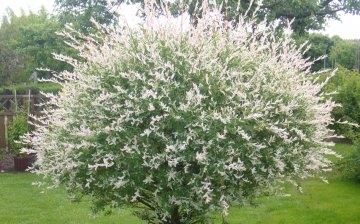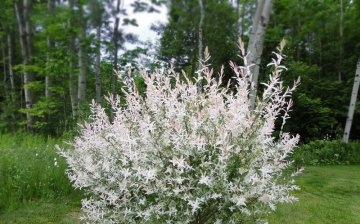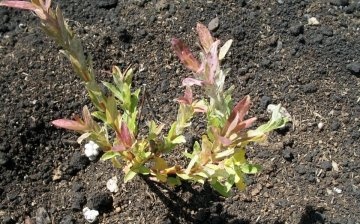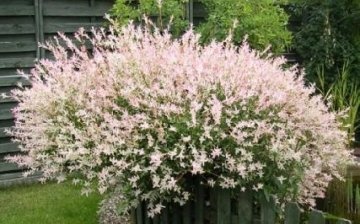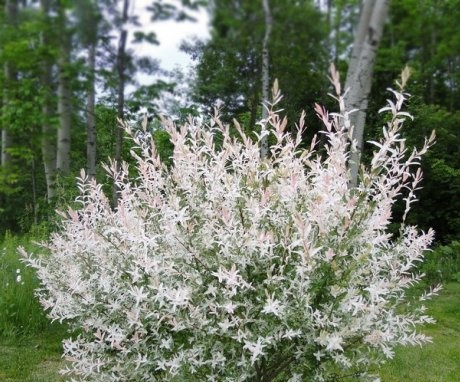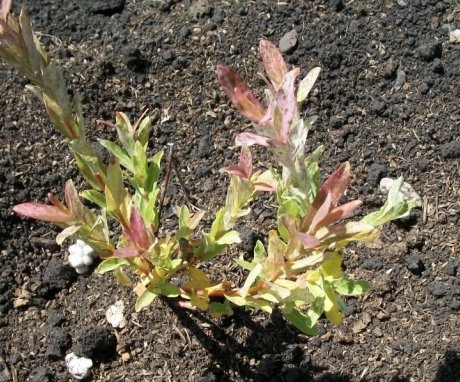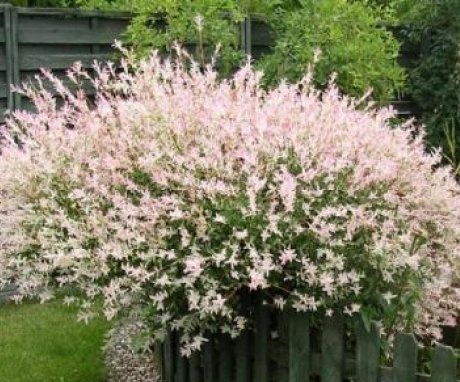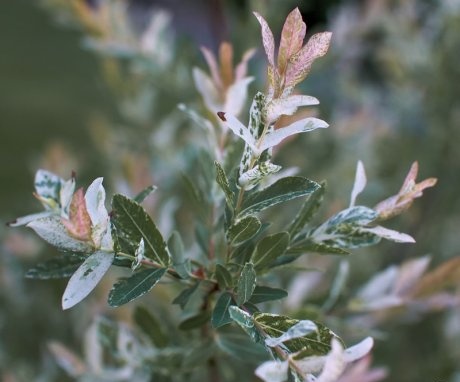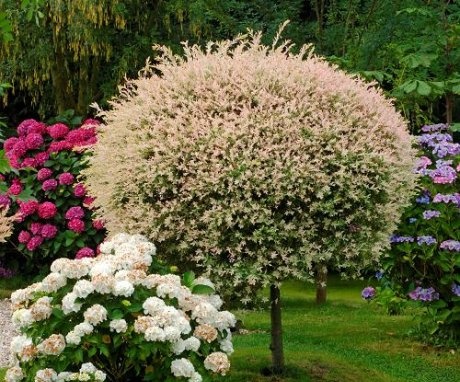Whole leaf willow - cultivation: from planting to care
Whole-leaved willow is bush, belonging to the Willow family. In nature, it can be found in Primorye, Japan and on the coast of the Korean Peninsula, where the whole-leaved willow grows in damp places along the banks of rivers.
Content:
- Structural features and description
- Planting a whole-leaved willow and reproduction
- Care Tips
- Diseases and pests
- Application in landscaping
Structural features and description
Currently, several varieties of whole-leaved willow have been bred, which are widely used in landscape design... The popularity of this willow is due not only to its decorative qualities, but also to its high resistance to frost and diseases.
In addition to growing in the form of a bush, this type of willow is grown in the form of a small tree.
The most famous and popular variety is Hacuro-nishiki, in the form of a tree it does not exceed 2 meters, the crown is formed by gracefully hanging thin shoots. The leaves of this variety at a young age have pink and white spots, then the pink color disappears and only white remains. In the form of a bush, the height reaches only 1.5 meters, but it is more resistant to the weather conditions of the Middle Lane, when in severe frosts young branches can be damaged to the level of snow. In such cases, the bush form is restored faster.
Characteristics of the whole-leaved willow:
- Plant height ranges from 1 to 3 meters.
- The branches of the shrub are rather spreading, predominantly of the same length, which gives it the correct shape.
- The color of mature branches can be yellow or red, the bark is shiny.
- The leaves are long, narrow, no more than 2 cm wide, can reach 7 cm in length. The top of the leaves is dark green, smooth. The bottom of the leaves is bluish in color. Young leaves can be reddish, which makes the tree even more decorative in the spring.
- Bloom occurs in May, before the leaves begin to bloom. The flowers are earrings about 1.5 cm long. The flowers are fragrant, the smell resembles a hyacinth.
Planting a whole-leaved willow and reproduction
For planting whole-leaved willow, as well as for all other species, you need to choose a place with sufficiently moist soil for good and rapid development of the seedling.
The planting site should also be well lit, which is especially important for varieties with colored leaves. In the shade, they will lose their decorative color and become just green, and the shoots will stretch out, and the tree or bush will lose its attractive crown shape, which will become sloppy and sparse.
The best time for planting whole-leaved willow is spring, late April - May.
For this, planting pits are prepared, in which humus or other organic fertilizerexcluding fresh manure. Be sure to make drainage from sand or broken bricks.
If the soil is heavy, then before returning it to the planting pit, it is mixed with peat, sand or humus. In order for the seedling to take root well and start growing within a few weeks after planting, it must be watered abundantly, you can even cover the near-trunk circle with grass or sawdust, for less moisture evaporation.
Whole-leaved willow propagates vegetatively, mainly with the help of cuttings... For this:
- Take young branches before the start flowering and leaf blooming, around April, in the southern regions it is possible earlier.
- Rooting takes place either in the ground or simply in a container with water. With both methods, the roots appear quickly enough, within 2-3 weeks.
- After the white roots that appear have reached a size of 2-3 cm, they can be planted in a permanent place or in a separate bed for growing.
- A seedling grown from a cuttings will reach its maximum size and bloom in about 3-4 years.
Another way is graft... It is used when you need to get the standard shape of the plant. As a rootstock, you can use local varieties of willow, which tolerate the frosts typical for the area well. This will protect the young tree from death in the first years of life.
Care Tips
Willow care is not difficult at all, it consists in carrying out the following activities:
- Watering one of the most important measures for caring for whole-leaved willow, especially if it is planted in an insufficiently moist place. Young plants are watered regularly throughout the summer; if there is a drought, older plants can be watered less frequently, but more abundantly. If the weather is hot and dry, then you can sprinkle the crown, but not in the bright sun, so as not to burn the leaves. In the heat, willows feel very good near water bodies, where the air is still more humid. Prefer wetter areas when planting, as root system Whole-leaved willow withstands short-term flooding better than constant drought.
- Pruning... Whole-leaved willow, like all its relatives, tolerates pruning well. Early spring pruning has a good effect on the formation of a bush, which becomes denser. Formative pruning can be carried out throughout the summer, especially for standard species in which the crown is maintained in a certain shape. The fact is that some varieties of whole-leaved willow give a large seasonal increase, reaching 30 cm per year, and if we neglect regular pruning, then by the end of the season the crown will be overgrown. In addition to losing its aesthetic appearance, it also threatens to damage it during heavy snowfalls in winter. Sanitary pruning is done in the spring. It consists in removing all frozen and damaged branches.
- Top dressing is carried out 1-2 times per season with organic or mineral fertilizers, on fertile soils, top dressing can be reduced to once.
- The trunk circle is cleaned of weeds and loosened, can also be applied mulching, or plant low-growing plants that will prevent the soil from drying out excessively.
- Preparing for winter... Although the whole-leaved willow is quite resistant to frost, nevertheless, in the most frosty winters, it can freeze to the level of snow cover. Therefore, young plants in the first years of life can be covered with any breathable material, or covered with leaves and sawdust. With standard forms, they sometimes do the same as with standard roses, in several steps they tilt to the ground and cover.
It is also worth paying attention so that the willow planting site is not in a place open to northern winds, which are more terrible for it than frosts, since the young branches completely dry out.
Diseases and pests
Whole-leaved willow is rarely affected by diseases and pests.
But sometimes its root system can be damaged by the larvae of the beetle, which are able to leave a young plant completely without roots, which usually leads to its death.
For the prevention of this pest, the trunk circle is treated with any drug in the composition, which contains imidacloprid.
It is also good, at least once a year, in the spring, to treat the crown of the tree with any fungicide in order to prevent the appearance of various fungal diseases.
Application in landscaping
The use of whole-leaved willow in landscape design is quite wide.It is mainly used:
- like a specimen of water
- in group landings
- for creating hedge
Standard species look very good as a tapeworm. Since the whole-leaved willow tolerates shearing well, you can give the crown of the tree the correct shape. For example, if you regularly remove large branches, then the growing young shoots will create a dense ball resembling a dandelion, especially this similarity will be noticeable if the leaves of the variety have white spots on the leaves.
A well-formed bush will also look good on the banks of a small artificial reservoir.
In group plantings, mainly bush forms are used. In order that adult plants do not shade each other during planting, they maintain a distance of 1 - 2 meters wide, depending on the purpose of planting. That is, if you plan to create a hedge, then make the distance about 1 meter. In order to form a dense hedge, it is better to plant plants in two rows in a checkerboard pattern. Although for growing hedges, the whole-leaved willow is still more suitable for the southern regions.
In any case, the whole-leaved willow will be a wonderful decoration of the garden; by its nature, it fits very organically into any composition, especially where there is a reservoir. Easy maintenance, will make it an indispensable inhabitant of any garden, giving elegance to any style. Even if the garden is small, you can find a place to plant a small tree on a trunk.
More information can be found in the video:



